The Chakras Or The Energy Centres
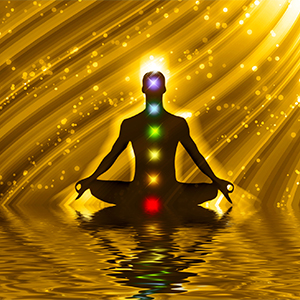 Most of us consider the material world and the physical body to be the only reality that exists, as only these can be discerned with the physical senses. Then what happens to the energy, the vital force which lends life to the physical body and provides it with sensations and means of expression. The power at work behind the body’s material appearance, with all its functions and capabilities, consists of a complex energy system without which the physical body does not exist. The centres that function as receivers, transformers and distributors of this various forms of energy needed by the body-mind-soul are the chakras / energy centres. Through the network of nadis, the vital energy gets transported throughout man’s subtle energy system to the
organs, cells, tissues, bones, systems, emotions, feelings, etc.
Most of us consider the material world and the physical body to be the only reality that exists, as only these can be discerned with the physical senses. Then what happens to the energy, the vital force which lends life to the physical body and provides it with sensations and means of expression. The power at work behind the body’s material appearance, with all its functions and capabilities, consists of a complex energy system without which the physical body does not exist. The centres that function as receivers, transformers and distributors of this various forms of energy needed by the body-mind-soul are the chakras / energy centres. Through the network of nadis, the vital energy gets transported throughout man’s subtle energy system to the
organs, cells, tissues, bones, systems, emotions, feelings, etc. Traditionally there are hundreds of little sub and minor chakras throughout our body in the cellular levels. The most important seven major chakras are located in the central vertical axis into the spine and towards the front of the body. They are cellular structures, rotating at different speeds of each chakra, connected to different organs, systems, psychological functions. They resemble funnel-shaped blossoms, each possessing different number of petals or blades, often referred to as lotus blossoms. The petals of the chakras represent nadis or energy channels, through which energy is able to flow into the chakra, wherefrom it is conveyed to the subtle bodies. The number of petals range from four of the root chakra to a thousand petals of the crown chakra.
The chakras are constantly in a state of rotation. It is the rotating speed that attracts a certain frequency energy in or give it off. Each chakra, depending on the energy that it works with, has a colour to it. The size and vibration of the chakra determines the amount and quality of energy that it works with. The two most important and fundamental forms of energy entering the human is via the root centre at the tip of the spine and the crown centre, at the top of the head. These two are connected through a pipe like pattern called sushumna nadi, passing along through the other five chakras. Sushumna is also the channel through which the kundalini power rises. The seven major chakras are Root chakra, Hara chakra, Solar Plexus, Heart chakra, Throat chakra, the Third Eye chakra, and the Crown chakra. The condition of the petals in the chakra and the pattern of energy going in and out, facilitates in doing the aura diagnosis. The chakras are the mirrors of ourselves in the body-mind-soul levels; for example:
Root or Muladhar chakra:
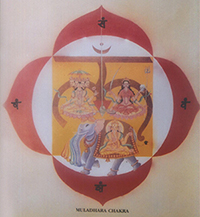 is located between anus and the root of penis. This chakra, consisting of four petals, is the junction where the nadis Ida, Pingla and Sushumna meet. Activation of this chakra awakens the Kundalini shakti and lets us get to know the Trikala Jnana (knowledge of the past, present and future). Hypo functioning brings about kidney dysfunction, lumbago, sciatica, hypogonadism; and hyper functioning creates arthritis, weakness of legs, depressive psychosis.
is located between anus and the root of penis. This chakra, consisting of four petals, is the junction where the nadis Ida, Pingla and Sushumna meet. Activation of this chakra awakens the Kundalini shakti and lets us get to know the Trikala Jnana (knowledge of the past, present and future). Hypo functioning brings about kidney dysfunction, lumbago, sciatica, hypogonadism; and hyper functioning creates arthritis, weakness of legs, depressive psychosis.
Hara or Swadhishtana chakra:
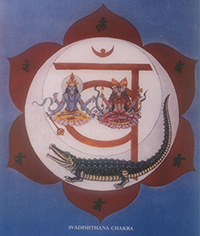 is located in the Sushumna nadi at the root of the penis over pubis. Consisting of six petals, controls functioning of reproductive system and large intestine. This chakra is associated with the taste sense and balances the water in our body. This chakra’s dysfunctioning can result in psychoneurosis, impotence-frigidity-infertility, tumours of testes/ovary, uterus problems, prostate.
is located in the Sushumna nadi at the root of the penis over pubis. Consisting of six petals, controls functioning of reproductive system and large intestine. This chakra is associated with the taste sense and balances the water in our body. This chakra’s dysfunctioning can result in psychoneurosis, impotence-frigidity-infertility, tumours of testes/ovary, uterus problems, prostate.
Solar Plexus or Manipur chakra:
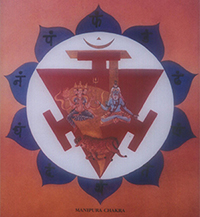 is located in Sushumna nadi in umbilicus. This has ten petals, and influences functioning of liver, pancreas, stomach, spleen, gall bladder, intestines and sympathetic nervous system. Fire being the element here, symbolizes digestion and absorption of food by us. Some dysfunctions results in cancer, diabetes, peptic ulcer, liver cirrhosis, gall bladder problem and skin psoriasis.
is located in Sushumna nadi in umbilicus. This has ten petals, and influences functioning of liver, pancreas, stomach, spleen, gall bladder, intestines and sympathetic nervous system. Fire being the element here, symbolizes digestion and absorption of food by us. Some dysfunctions results in cancer, diabetes, peptic ulcer, liver cirrhosis, gall bladder problem and skin psoriasis.
Heart or Anahata chakra:
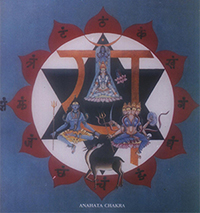 is located between shoulder blades, relates to cardiac plexus. Consisting of twelve petals, controls the functioning of heart, lungs, thymus, circulatory system. The life energy is anchored here, controlling blood circulation to feed every cell in the body. Anahata chakra gets compassion from the spiritual love which is experienced as a sense of oneness with others. Abnormal functioning can result in depressive psychosis, personality disorders, heart attacks, hypertension and blood disorders.
is located between shoulder blades, relates to cardiac plexus. Consisting of twelve petals, controls the functioning of heart, lungs, thymus, circulatory system. The life energy is anchored here, controlling blood circulation to feed every cell in the body. Anahata chakra gets compassion from the spiritual love which is experienced as a sense of oneness with others. Abnormal functioning can result in depressive psychosis, personality disorders, heart attacks, hypertension and blood disorders.
Throat or Vishudha chakra:
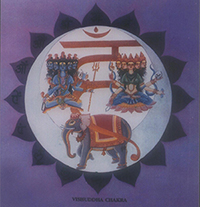 is located in the throat region, at the back of the neck. This has sixteen petals, and helps functioning of respiratory system, thyroid and parathyroid. It converts thoughts into word form. The prana operates at a very high vibratory level of pure consciousness and hence is the great gate of liberation or moksha. Dysfunctioning of this chakra can cause vertigo, anaemia, allergy, fatigue, sore throat, asthma, hyperthyroidism, etc.
is located in the throat region, at the back of the neck. This has sixteen petals, and helps functioning of respiratory system, thyroid and parathyroid. It converts thoughts into word form. The prana operates at a very high vibratory level of pure consciousness and hence is the great gate of liberation or moksha. Dysfunctioning of this chakra can cause vertigo, anaemia, allergy, fatigue, sore throat, asthma, hyperthyroidism, etc.
Third Eye or Ajna chakra:
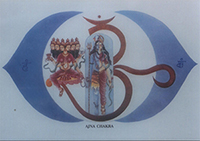 is located over occiput in line with glabella. This chakra deals with soul force, vision, intuition, lower brain, left eye, nose and cerebellum. From here, intuition is transmitted to lower centres and the mind. This controls functioning of pituitary gland, handling growth, metabolic and physical activities. Dysfunctioning can result in pituitary problems, migraine, sinusitis, disorders of eyes and ears.
is located over occiput in line with glabella. This chakra deals with soul force, vision, intuition, lower brain, left eye, nose and cerebellum. From here, intuition is transmitted to lower centres and the mind. This controls functioning of pituitary gland, handling growth, metabolic and physical activities. Dysfunctioning can result in pituitary problems, migraine, sinusitis, disorders of eyes and ears.
Crown or Sahasrara chakra:
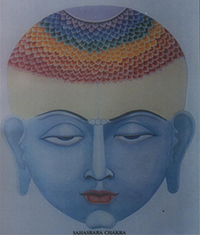 is located over vertex of head. It controls brain functions, right eye and pineal gland. This is the dwelling place of the human soul and has the energy of spiritual will – synthetic and dynamic. This chakra, due to its highest subtle vibratory energy, is different from others in constitution and effect; i.e. it works with consciousness and helps in the journey towards moksha. Dysfunctioning can result in depressive psychosis, encephalitis, brain tumours.
is located over vertex of head. It controls brain functions, right eye and pineal gland. This is the dwelling place of the human soul and has the energy of spiritual will – synthetic and dynamic. This chakra, due to its highest subtle vibratory energy, is different from others in constitution and effect; i.e. it works with consciousness and helps in the journey towards moksha. Dysfunctioning can result in depressive psychosis, encephalitis, brain tumours.Chakras are very supportive in healing disorders in body and mind-emotion. Even the sounds of the chakras can be used for healing purposes. The way of healing chakras will be guided during the sessions by Mrs. Rani Venkat
Top